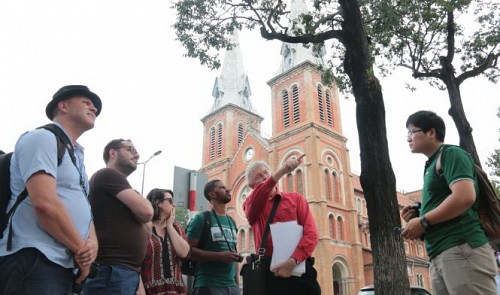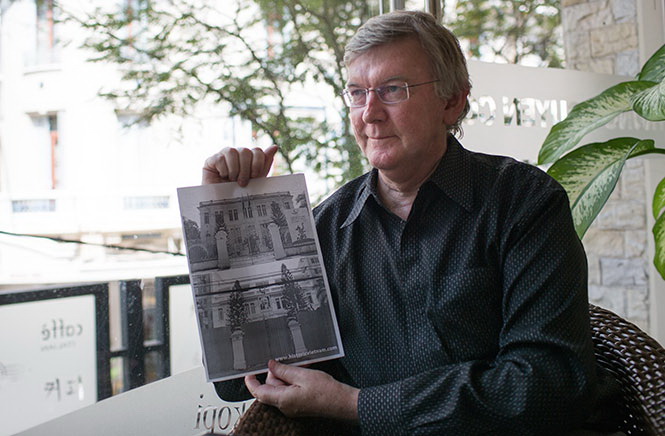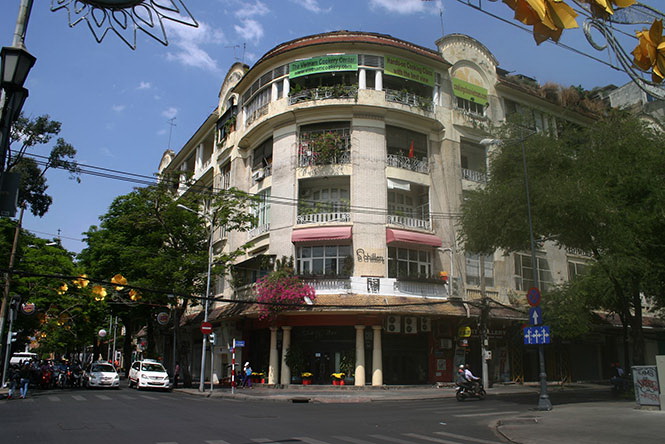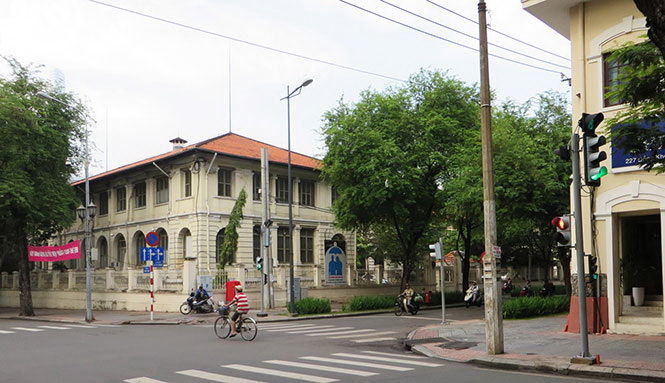Exploring Ho Chi Minh City’s heritage with British ‘tour guide’

An enthusiast of the city’s heritage, Tim Doling has recently begun offering guided tours around downtown areas and Cho Lon in District 5, where many Vietnamese of Chinese origin live.
His tours focus on strolls around the country’s largest economic hub, during which he brings the city to life with insightful anecdotes and erudite observations.
The tours are a vivid representation of the astounding knowledge and experience that Doling, mainly based in the city since the 1990s, has incorporated in his guidebook, “Exploring Ho Chi Minh City.”
The book, published in mid-2014, accentuates time-honored yet lesser-known edifices as well as offers a fresh slant on the city’s popular historic vestiges.

Tim Doling shows a black-and-white photo of a time-honored structure in Ho Chi Minh City.
Photo: Tuoi Tre
His profound yet intimate knowledge of the buildings’ history has surprised holidaymakers and even long-time residents.
In late September, two Tuoi Tre (Youth) newspaper reporters joined four travelers from the UK and the U.S. in one of Doling’s four-hour heritage excursions around downtown Ho Chi Minh City.
The trip, which departed from a square in front of the Saigon Notre-Dame Basilica, involved a lot of walking and no car or motorbike rides.
Showing the expectant holidaymakers along Dong Khoi Street, Doling provided an oral sketch of its precursor, Catinat Street, which was home to some unique architectural works.
The pundit also detailed the bygone days of other architectural icons and tourist attractions, including the Majestic Hotel, Saigon Central Post Office, and the Albert Portail Bookstore.
He also showed the tourists black-and-white photos to add weight to his stories.
“[The former] Catinat Street really lives up to its name as Southeast Asia’s Canebière [the most famous street in Marseille, France],” Brandon Coleman, a U.S. vacationer, exclaimed.

Catinat Building, located at 26 Ly Tu Trong Street in downtown Ho Chi Minh City.
Photo: Tuoi Tre
Doling went on to show the group of vacationers around several of the city’s other hallmarks such as the Municipal Theater, Continental and Caravelle hotels.
He then drew the tourists’ attention to the Saigon Central Post Office, pointing out that it is not the city’s first post facility.
The first post office was temporarily built in the early 1860s at the site where Metropolitan Building, along Dong Khoi Street, is now.
The French constructed the city’s second post office in the former Catinat Street in 1878, which was later replaced with the current central post office in the late 1880s.
To the tourists’ surprise, Doling revealed that Caravelle Hotel, situated on Dong Khoi Street, is the first-ever theater to be built in the city.
Constructed in the early 1870s, the cozy theater was burned down around 1882.
The French then built the existing Municipal Theater in 1898.
Doling later guided the sightseers to such other streets as Ham Nghi, Ho Tung Mau, Pasteur and Ly Tu Trong, also located in the downtown area, and went on to hold them in awe with his stories.
He also pointed to a small market on Ton That Dam Street, also in District 1, as the precursor to the city’s iconic Ben Thanh Market.
Following historical turmoil, the market was moved to what is now Bitexco Financial Tower, the city’s tallest skyscraper, and the State Bank of Vietnam mansion.
Nguyen Hue Street, known for its recently opened pedestrian street, was once a ditch in front of the market.

An age-old building situated on Ly Tu Trong Street. Photo: Tuoi Tre
In mid-1911, as the market became dilapidated and faced collapse, the French made it a thing of the past and built the current Ben Thanh Market.
An unexpected twist came when Doling took the tourists to Ham Nghi Street, also located in the city’s heart, and introduced them to Dong Phat Restaurant, previously known for its mouth-watering roasted duck.
Nguyen Thi Nam, 67, daughter-in-law of one of the restaurant’s two co-owners, revealed that the eatery has fallen into oblivion since 1975 and is hardly known by today’s inhabitants and tourists.
Nam was surprised and deeply moved that a foreigner had chosen to introduce her father-in-law’s restaurant.
“Cultural travelers are currently the biggest spenders, those who are keen on lesser-known knowledge of [Ho Chi Minh City] and willing to spend a lot,” Doling said at the end of his September tour.
“I’m astonished that several veteran city dwellers find nothing special about the city or take its allure for granted. That’s when I decided to launch the heritage tours around [Ho Chi Minh City] to prove everyone wrong.”
“Everyone should join hands to preserve the tourism sector’s ‘gold mine’, so that we won’t regret their ‘extinction’ later,” he said.
| According to Tim Doling’s LinkedIn page, originally trained as a medieval historian, he has spent most of his career in the cultural sector, running theaters and arts centers in several countries and undertaking cultural projects in Asia, Africa and Europe for the UNESCO and the British Council. From 1999 to 2004, he worked with the Vietnamese Ministry of Culture and Information on a Ford Foundation-funded project to develop arts management training curricula in three universities in Hanoi. Doling has authored several books on Vietnam’s landscapes and culture, including “The Railways and Tramways of Việt Nam” and “Exploring Hội An and Đà Nẵng,” and guidebooks on the country’s North West and North East regions. |
What the stars mean:
★ Poor ★ ★ Promising ★★★ Good ★★★★ Very good ★★★★★ Exceptional
Latest News
More News
- The destinations powering Vietnam’s festive season travel demand (December 04, 2025 | 18:33)
- Vietnam named among the world’s most exciting winter destinations (December 04, 2025 | 15:10)
- Phu Tho emerges as northern Vietnam’s new tourism hub (December 01, 2025 | 17:00)
- Vietjet completes Airbus A320/A321 updates ahead of deadline (December 01, 2025 | 09:49)
- Vietjet resumes Con Dao flights from early December (November 28, 2025 | 15:24)
- Free tickets, Lunar New Year promotions on offer at Vietjet Mega Livestream (November 26, 2025 | 15:32)
- Scandinavian Airlines and Vietnam Airlines broaden agreement with new routes (November 25, 2025 | 17:04)
- Halong Cruise Port welcomes over 3,100 international visitors (November 12, 2025 | 18:06)
- Vietnam.travel climbs to second place in Southeast Asia website rankings (November 12, 2025 | 18:01)
- Cat Ba named among Southeast Asia’s top island adventures (November 11, 2025 | 18:09)

















 Mobile Version
Mobile Version